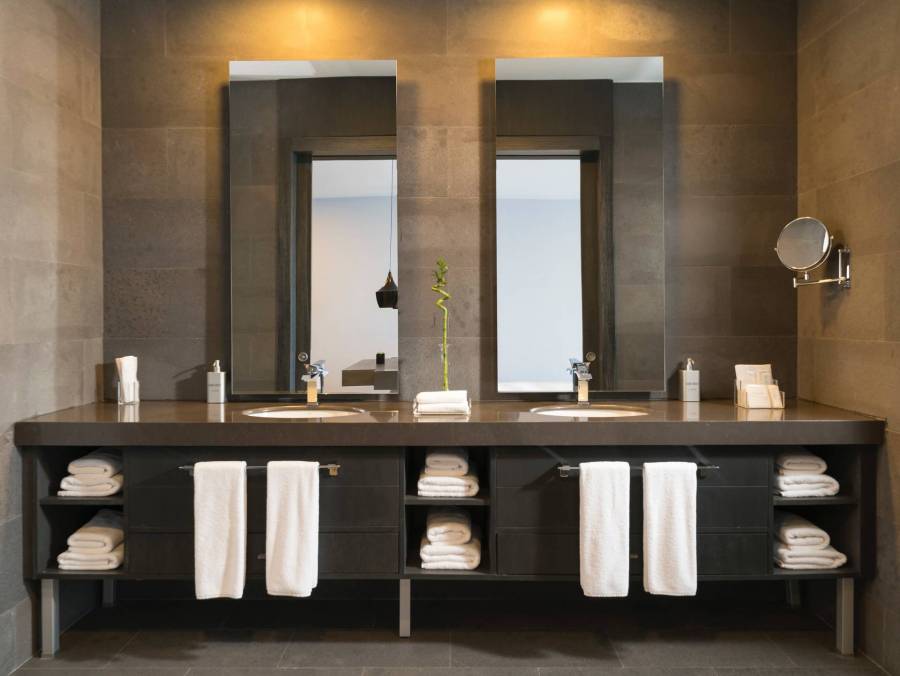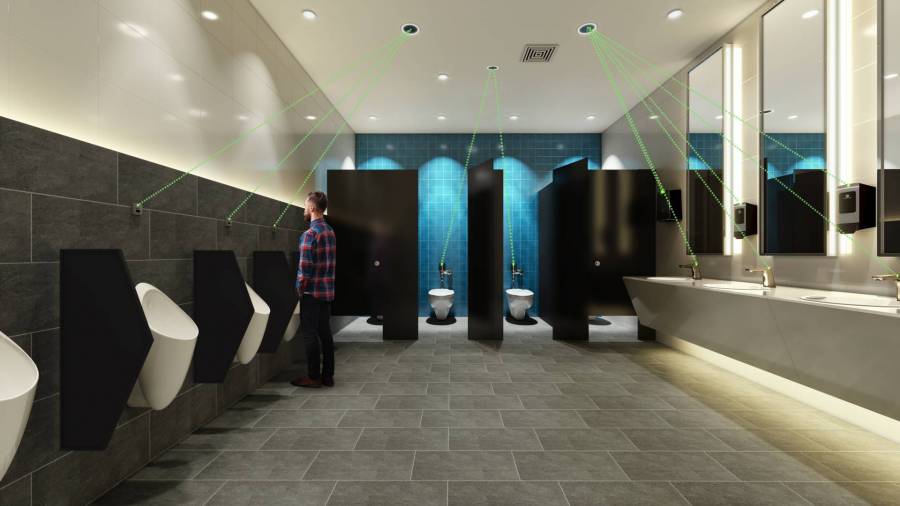The Internet of Things (IoT) has already fundamentally changed the way we live. Ever since Kevin Ashton coined the term in 1999, the excitement around IoT technology has only continued to grow and is turning into widespread deployments. Here is wireless power and how IoT fixtures will power the bathroom of the future.
We hear a lot of talk about smart cars, smart homes, and even smart cities. And the ubiquity of connected devices like Google Home, Amazon Echo, and Samsung’s Smart Things Hub indicates the trend shows no signs of slowing down. Analysts predict there will be more than 64B IoT devices worldwide by 2025.
It seems that much of the conversation has been about connected and smart devices used in residential settings or for personal use. Because of this focus on the consumer IoT marketplace, perhaps the last thing that comes to mind when you think of smart IoT applications are smart devices in a public restroom.
The potential is huge for innovations that increase efficiency and enhance the guest experience in public restrooms.
Implementing IoT technology in a public restroom environment can benefit consumers, facility managers, and maintenance personnel, and how a new technology known as long-range wireless power can enable and accelerate these implementations.
In Search of Better Bathrooms
It’s important for public spaces to have clean bathrooms.
That’s one of the reasons why many commercial bathrooms – the ones you use at airports, hospitals, sports venues, etc. – are loaded with battery-operated devices like touchless faucets, automated soap dispensers, automatic flush valves, and other sensor-operated fixtures.
The sheer number of these devices spread across multiple bathrooms creates maintenance issues for facilities managers.
Consider:
- To keep devices and fixtures working, batteries need to be constantly replaced. If batteries last three months on average, and an airport has 500 battery-operated devices, more than five devices on average will need batteries replaced every day. The problem is that facilities managers don’t know exactly which devices these will be.
- When a battery runs dead it causes one or more devices to stop working (e.g. no flush, no soap, no water). The inconvenience usually leads to customer frustration, complaints, and in many retail locations, lost business.
- Sometimes, especially in hospitals, there are regulations that mandate that these sanitary devices keep working, and outages are unacceptable.
- Then, of course, there is the cost of batteries, the man-hours to replace them, and the environmental impact of disposing of used batteries.
These are just a few of the frustrations plaguing maintenance personnel.
Although newly built bathrooms are more likely to have electricity, cables, and wires present their own set of challenges for facilities managers. For instance, when retrofitting existing buildings, it’s often more cost-effective to “cut the cord” and use wireless power.
Rick Szcodronski, senior associate, technology consulting for Environmental Systems Design, Inc. said, “Wireless devices are reliable, secure, and the cheapest way to bring IoT technology to existing buildings.”
As the power consumption needs to increase and the electrical installation costs continue to rise, facility managers and maintenance personnel are looking for environmentally-friendly, cost-effective ways to meet the power consumption needs of the modern restroom.
Let’s face it — the condition of a public bathroom can affect public perceptions.
- Fifty-two percent of Americans said that they would “definitely” or “probably” spend more money at businesses with well-maintained bathrooms.
- Fifty-five percent report being unlikely to return to a business after a bad restroom experience.
- The Airports Council International, the official association for the world’s airports, did a survey, and travelers said that washroom cleanliness and terminal cleanliness affect their overall satisfaction more than any other infrastructure factor.
Batteries on the Blink and Wires in the Way
Cleanliness and customer experience aren’t the only challenges when it comes to maintaining public restrooms.
For example, as energy consumption in modern buildings increases, energy efficiency has become an important aspect of building management.
Although restroom technology has improved in the past few years, many builders and contractors have become cost-conscious, opting for the least expensive fixtures. This combined with unreliable energy from batteries often means customers have a less than stellar experience using public restrooms. Think unfilled soap dispensers, faucets that don’t work, and wet hands with no paper towels available.
- There is a desire to have smart soap and toilet paper dispensers.
- Automatic lighting systems are a must in commercial restrooms.
- The demand is great for IoT services in most public buildings.
- Power delivery methods can become a problem without proper IoT installations.
One problem is that as bathrooms get smarter and more connected, it takes more effort to service the fixtures.
The new challenge for facility management professionals.
Property and facility managers are looking to use IoT technology in the restroom to help them provide well-maintained restrooms, which need an energy source that isn’t limited by battery capacity or the logistics of running additional cabling or installing new electrical outlets.
Not to mention, wires and cables can be damaged by cleaning crews and can also cause tripping hazards.
Building managers, out of necessity, are turning to IoT devices that rely on wireless power so they can better allocate resources and resolve problems before they affect the customers.
What happens when you improve power delivery to public spaces?
Typically, wireless charging solutions are easier to install, maintain, and repair than wired ones. Using wireless power in public restrooms helps eliminate the largest stumbling blocks to a smart retrofit or new smart installation.
The Future of IoT Fixtures: It’s Not What You Think
Until recently, long-range wireless power was the stuff of science fiction.
Now, companies like Wi-Charge have developed long-range wireless charging solutions that are powerful, efficient, safe, and perfectly suited to solve the power consumption needs of modern public restroom IoT fixtures.
Wireless technology is a cost-effective way to power commercial spaces like public bathrooms. It’s also a novel technology-based solution to improving cleanliness and guest experience, which creates value for everyone involved in the use and maintenance of public restrooms.
Let’s take a look at some more ways that consumers, facility managers, and maintenance personnel can benefit from IoT-enabled restrooms devices.
- IoT technology like smart lighting controls, occupancy sensors, and smart thermostats help property owners save money. These controls improve the experience for customers who use these public bathrooms.
Dallas Fort Worth International Airport is an airport expected to service more than 80 million passengers annually in the next five years. DFW is investing millions of dollars in smart bathroom technology for the airport’s 135 restrooms.
Sensors in the airport’s bathrooms will alert maintenance staff when supplies like soap, paper towels, and toilet paper run low. Staff will be alerted and will restock restrooms on demand. Out-dated time-scheduled approaches will no longer be used.
Other airports, such as William P. Hobby Airport, George Bush Intercontinental Airport, and Hartsfield-Jackson Atlanta International Airport currently use similar technology to increase operational efficiency.
- IoT technology can transmit cleaning data and inventory levels in real-time, enabling management to deploy critical resources efficiently. High engagement in proactive maintenance is deployed. Smart devices anticipate, replenishment, or repair before issues become a problem.
For example, the Kimberly-Clark Professional’s Onvation™ smart restroom management system sends real-time alerts to property managers or maintenance staff on foot traffic and product usage. This allows the cleaning staff to optimize cleaning schedules and inventory levels.
Smart meters, smart thermostats, and smart faucets can reveal valuable data. Combined with analytics, the power and water consumption in public restrooms provide data for additional innovation.
The Bellagio in Las Vegas, Nevada, uses IoT-enabled sensors as part of their smart water management system. Bellagio’s system monitors and analyzes 1,440 data points every day as part of their water conservation initiatives.
Meeting business sustainability goals.
Again, these are just a few real-world scenarios where IoT devices in the restroom help make sure that customers’ expectations are met and help businesses meet sustainability goals. Using technology to deliver a better user experience isn’t new – except in the restroom.
So why is wireless power the smart way to power these battery-operated devices when you want to add IoT capabilities?
All these IoT capabilities require more power than batteries can provide. Property managers don’t have the resources to replace batteries even more frequently than they do now. Wireless power delivers dual benefits. Eliminating battery replacements and powering the IoT capabilities of the bathroom of the future are lofty goals.
Wireless power helps deliver the energy that is needed for these functions and opens the door for on-demand advertising, faucet lighting, or other features that are currently limited by battery capacity.
2020 and Beyond
Restrooms are among the highest-maintenance rooms in most commercial buildings. There is an opportunity to improve upon how most restrooms are managed today.
A smart bathroom offers commercial and public property managers convenience, control, cost savings, and increased energy efficiency. At the same time, it offers users improved hygiene, stocked and well-maintained bathrooms, and better customer experience.
Bringing IoT technology to the public restroom is the next step in facilities management. In other words, smart restrooms connected to the IoT are the future, and that future starts today. Vendors should consider wireless power, and builders should demand it.


























